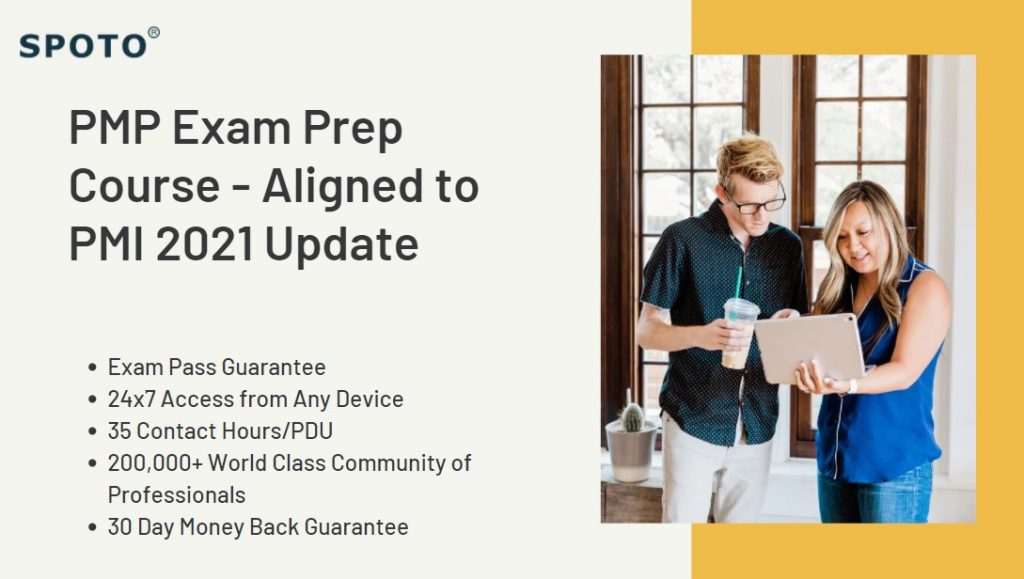PMP® is a challenging platform for all project managers nowadays. Every project manager aspires to pass the PMP certification exam on the first try. The following are some basic question sets to give you an idea of the types of questions asked in the examination:
1. The project has been hampered by changes to the project charter. Who is ultimately responsible for determining whether these changes are necessary?
The first is the project manager.
B. The project’s management team.
C. The supporter.
D. The Parties Involved.
Answer: C. Because the sponsor creates the project charter, he or she should assist the project manager in keeping changes to the charter under control. The sponsor bears the primary responsibility.
2. EXCEPT: ALL OF THE FOLLOWING ARE PARTS OF AN EFFECTIVE CHANGE MANAGEMENT PLAN
A. Methodologies
B. report format standard.
C. Gatherings.
D. Lessons Discovered.
The answer is D. A change management plan includes the processes and procedures that enable the evaluation and tracking of changes to run smoothly. The review of processes and procedures to improve them (choice D) is a lesson learned; they are not part of the system.
3. You are the new project manager with no prior project management experience. You’ve been tasked with developing a new project. In this case, it would be BEST to rely on during planning to increase your options.
A. Your experience and intuition.
B. Analysis of stakeholders.
C. Historical details.
D. Configuration administration.
Answer: C. Because you lack experience, you must rely on the experiences of others. This information is preserved in previous projects’ historical records.
4. A work authorization system can be used to do the following:
A. Control who performs each activity.
B. Control when and in what order work is completed.
C. Control when each activity is completed.
D. Control who does what and when it is done.
Answer: B. The schedule and responsibility assignment matrices are used to manage who does which activities (Choices A and D). The project schedule governs when each activity is completed (Choice C). A work authorization system is used to coordinate when and in what order work is performed so that work and people can interact with other work and people in an appropriate manner.

5. You are appointed project manager in the midst of the project. The project is within the baselines, but the customer is dissatisfied with the project’s performance. What should be your first step?
A. Talk about it with the project team.
B. Rearrange baselines.
C. Rework the contract.
D. Schedule a meeting with the customer.
The answer is D. First, you must determine why a customer is dissatisfied. Then, meet with the team to discuss options.
6. The criteria of the Close Project or Phase process is an output of the process.
A. The project archive.
B. Project scope.
C. Project management strategy.
D. Risk management strategy.
Answer: A. In initiating, the project chart (choice B) is created. The planning process group produces the project management plan (option C). The risk analysis plan is incorrect (choice D).
7. EXCEPT for the following, all of the following would occur during the Close Project or Phase process:
A. Making use of lessons learned.
B. Formal approval
C. Cutting back on resource spending.
D. Conducting a benefit-cost analysis
Answer: D. Benefit-cost analysis (choice D) is performed earlier in the project to aid in the selection of alternatives. All other decisions are made at the end. As a result, Choice D is the best answer.
8. You created the project charter but were unable to get it approved. Your manager and his boss have requested that the project begin as soon as possible. Which of the following is the BEST option?
A. Implement an integrated change management process.
B. Demonstrate to your manager the consequences of proceeding without approval.
C. Concentrate on completing projects with signed project charters.
D. Begin working only on the critical path activities.
Answer: B. The best thing to do is to demonstrate the impact. This is the only option that eliminates the problem in the future – it is always the best option. The other option is to pretend the problem does not exist.
9. All technical work on the project has been completed. Which of the following tasks has yet to be completed?
A. Check the Scope
B. Prepare Risk Reactions
C. Develop a staffing management strategy D. Apply lessons learned
Answer: D. Scope verification is performed during the monitoring and controlling process group, not the closing process group. Choices 2 and 3 have been completed earlier in the project. The lessons learned (option D) can only be completed after the work is finished.
10. All of the following are forms of power derived from the Project Manager’s position.
Formal A.
B. Incentives
C. Punishment
D. Expert Answer: D. A project manager has a formal, reward, and disciplinary powers. However, simply having power does not make a project manager a technical project management expert.
11. Maslow’s hierarchy of needs’ highest point is referred to as
A. Physiological fulfillment
B. Survival Achievement C. Association Requirement
D. Self-esteem
The answer is D.
Have fun learning! We wish you the best of luck on your path to PMP® certification!





